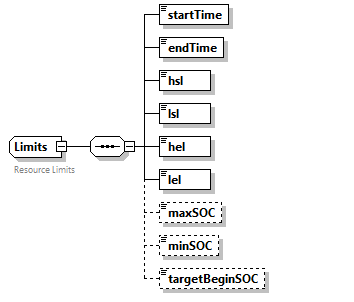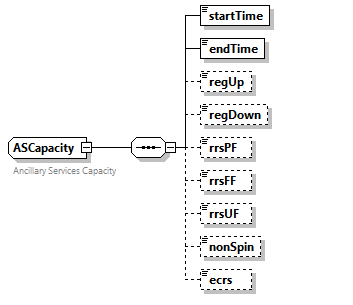Current Operating Plan (COP)
Current Operating Plan (COP)
The following diagram describes the structure of a Current Operating Plan (COP), where the COP provides a schedule for a resource:

The structures for Limits and ASCapacity are shown in the following diagrams. If more than one ResourceStatus, Limits, or ASCapacity block is provided, start and end times must not overlap:


COP submissions are never cancelled, as a COP must be submitted. A resubmission of a COP overwrites the previous submission. On submission, the following table describes the items used for a COP:
| Element | Req? | Datatype | Description | Values |
|---|---|---|---|---|
| startTime | N | dateTime | Start time for COP | Valid start hour boundary for trade date |
| endTime | N | dateTime | End time for COP | Valid end hour boundary for trade date |
| externalId | N | string | External ID | QSE supplied |
| resource | K | string | Resource | Valid resource name |
| combinedCycle | N | string | Combined cycle | Not required. Value ignored if provided. |
| ResourceStatus/startTime | Y | dateTime | Start time for status | Valid hour boundary |
| ResourceStatus /endTime | Y | dateTime | End time for status | Valid hour boundary |
| ResourceStatus /operatingMode | Y | string | status | Valid status code |
| Limits/startTime | Y | dateTime | Start time for limits | Valid hour boundary |
| Limits/endTime | Y | dateTime | End time for limits | Valid hour boundary |
| Limits/hsl | Y | float | High sustained limit in MW | >=0 |
| Limits/lsl | Y | float | Low sustained limit in MW | >=0 |
| Limits/hel | Y | float | High emergency limit in MW | >=0 |
| Limits/lel | Y | float | Low sustained limit in MW | >=0 |
| Limits/maxSOC | N | float | Maximum operating state of charge for given hour ending | |
| Limits/minSOC | N | float | Minimum operating state of charge for given hour ending | |
| Limits/targetBeginSOC | N | float | Target state of charge at beginning of given hour ending | |
| ASCapacity/startTime | Y | dateTime | Start time for AS capacity schedule | Valid hour boundary |
| ASCapacity/endTime | Y | dateTime | End time for AS capacity schedule | Valid hour boundary |
| ASCapacity/regUp | Y | float | Regulation up MW | >= 0 |
| ASCapacity/regDown | Y | float | Regulation down MW | >= 0 |
| ASCapacity/rrsPF | Y | float | Responsive reserve MW | >= 0 |
| ASCapacity/rrsFF | Y | float | Responsive reserve MW | >= 0 |
| ASCapacity/rrsUF | Y | float | Responsive reserve MW | >= 0 |
| ASCapacity/nonSpin | Y | float | Non-spinning MW | >= 0 |
| ASCapacity/ecrs | Y | float | ERCOT Contingency Reserve MW | >= 0 |
The following is an XML example for a COP:
<BidSet xmlns="http://www.ercot.com/schema/2007-06/nodal/ews" xmlns:ns2="http://www.ercot.com/schema/2007-06/nodal/ews">
<tradingDate>2021-11-09</tradingDate>
<COP>
<startTime>2021-11-09T00:00:00-06:00</startTime>
<endTime>2021-11-10T00:00:00-06:00</endTime>
<resource>RES_1</resource>
<ResourceStatus>
<startTime>2021-11-09T23:00:00.000-06:00</startTime>
<endTime>2021-11-10T00:00:00.000-06:00</endTime>
<operatingMode>ONRL</operatingMode>
</ResourceStatus>
<Limits>
<startTime>2021-11-09T23:00:00.000-06:00</startTime>
<endTime>2021-11-10T00:00:00.000-06:00</endTime>
<hsl>20</hsl>
<lsl>0</lsl>
<hel>20</hel>
<lel>0</lel>
<maxSOC>15</maxSOC>
<minSOC>5</minSOC>
<targetBeginSOC>5</targetBeginSOC>
</Limits>
<ASCapacity>
<startTime>2021-11-09T23:00:00.000-06:00</startTime>
<endTime>2021-11-10T00:00:00.000-06:00</endTime>
<regUp>0</regUp>
<regDown>0</regDown>
<rrsPF>0</rrsPF>
<rrsFF>0</rrsFF>
<rrsUF>20</rrsUF>
<nonSpin>0</nonSpin>
<ecrs>0</ecrs>
</ASCapacity>
</COP>
</BidSet>
And the corresponding response:
</ns1:BidSet><ns1:BidSet xmlns:ns1="http://www.ercot.com/schema/2007-06/nodal/ews">
<ns1:tradingDate>2021-11-09</ns1:tradingDate>
<ns1:COP>
<ns1:mRID>QSAMP1.20211109.COP.RES_1</ns1:mRID>
<ns1:externalId/>
<ns1:status>ACCEPTED</ns1:status>
<ns1:error>
<ns1:severity>INFORMATIVE</ns1:severity>
<ns1:text>Successfully processed the ERCOT COP.</ns1:text>
</ns1:error>
</ns1:COP>
</ns1:BidSet>
The terms maxEmergency, maximumEconomic, minEmergency, and minimumEcononic are used to in order to be consistent with the IEC CIM.
Currently defined resource operatingModes include:
ONRUC – On-Line and the hour is a RUC-Committed Interval
ONREG – On-Line Resource with Energy Offer Curve providing Regulation Service
ON – On-Line Resource with Energy Offer Curve
ONDSR – On-Line Dynamically Scheduled Resource
ONOS – On-Line Resource with Output Schedule
ONOSREG – On-Line Resource with Output Schedule providing Regulation Service
ONDSRREG – On-Line Dynamically Scheduled Resource providing Regulation Service
ONTEST – On-Line Test with Output Schedule
ONEMR – On-Line EMR (available for commitment or dispatch only for ERCOT-declared Emergency Conditions; the QSE may appropriately set LSL and HSL to reflect operating limits)
ONRR – On-Line as a synchronous condenser (hydro) providing Responsive Reserve but unavailable for dispatch by SCED and available for commitment by RUC
OUT – Off-Line and unavailable
OFFNS – Off -Line but reserved for Non-Spin
OFF – Off-Line but available for commitment by DAM and RUC
EMR – Available for commitment only for ERCOT-declared Emergency Condition events; the QSE may appropriately set LSL and HSL to reflect operating limits
ONRGL – Available for Dispatch of Regulation Service by Load Frequency Control (LFC) and, for any remaining Dispatchable capacity, by SCED with an Real-Time Market (RTM) Energy Bid
ONCLR – Available for Dispatch as a Controllable Load Resource by SCED with an RTM Energy Bid
ONRL – Available for Dispatch of RRS Service, excluding Controllable Load Resources
OUTL – Not available
ONOPTOUT – On-Line and the hour is a RUC Buy-Back Hour
OFFQS – Off-Line but available for SCED deployment. Only qualified Quick Start Generation Resources (QSGRs) may utilize this status.
EMRSWGR - status can be submitted individually for qualified SWGRs only and Operating Hour(s) for which they are applicable during the Adjustment Period
ONECRS – On-Line as a synchronous condenser providing ERCOT Contingency Response Service (ECRS) but unavailable for Dispatch by SCED and available for commitment by RUC
ONECL - Available for Dispatch of ECRS, excluding Controllable Load Resources
Currently defined resource operatingModes include:
- ONRUC – On-Line and the hour is a RUC-Committed Interval
- ON – On-Line Resource with Energy Offer Curve
- ONTEST – On-Line Test with Output Schedule
- ONOS – On-Line Resource with Output Schedule
- OFF – Off-Line but available for commitment by DAM and RUC
- ONEMR – On-Line EMR (available for commitment or dispatch only for ERCOT-declared Emergency Conditions; the QSE may appropriately set LSL and HSL to reflect operating limits)
- OUT – Off-Line and unavailable
- EMR – Available for commitment only for ERCOT-declared Emergency Condition events; the QSE may appropriately set LSL and HSL to reflect operating limits
- OUTL – Not available
- ONOPTOUT – On-Line and the hour is a RUC Buy-Back Hour
- OFFQS – Off-Line but available for SCED deployment. Only qualified Quick Start Generation Resources (QSGRs) may utilize this status.
- EMRSWGR - status can be submitted individually for qualified SWGRs only and Operating Hour(s) for which they are applicable during the Adjustment Period
- ONL - On-Line and available for Dispatch by SCED or providing Ancillary Services.
- ONSC - Resource is On-Line operating as a synchronous condenser and available to provide Responsive Reserve (RRS) and ECRS, if qualified and capable, and for commitment by RUC, but is unavailable for Dispatch by SCED. For SCED, Resource Base Points will be set equal to the telemetered net real power of the Resource available at the time of the SCED execution